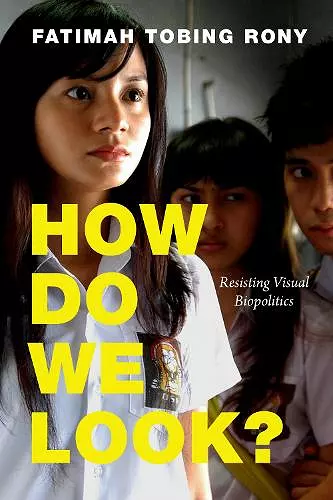How Do We Look?
Resisting Visual Biopolitics
Format:Hardback
Publisher:Duke University Press
Published:25th Jan '22
Currently unavailable, and unfortunately no date known when it will be back
This hardback is available in another edition too:
- Paperback£20.99(9781478014607)

In How Do We Look? Fatimah Tobing Rony draws on transnational images of Indonesian women as a way to theorize what she calls visual biopolitics—the ways visual representation determines which lives are made to matter more than others. Rony outlines the mechanisms of visual biopolitics by examining Paul Gauguin’s 1893 portrait of Annah la Javanaise—a trafficked thirteen-year-old girl found wandering the streets of Paris—as well as US ethnographic and documentary films. In each instance, the figure of the Indonesian woman is inextricably tied to discourses of primitivism, savagery, colonialism, exoticism, and genocide. Rony also focuses on acts of resistance to visual biopolitics in film, writing, and photography. These works, such as Rachmi Diyah Larasati’s The Dance that Makes You Vanish, Vincent Monnikendam’s Mother Dao (1995), and the collaborative films of Nia Dinata, challenge the naturalized methods of seeing that justify exploitation, dehumanization, and early death of people of color. By theorizing the mechanisms of visual biopolitics, Rony elucidates both its violence and its vulnerability.
“Fatimah Tobing Rony's passionate appeal for a different kind of filmmaking that might interrupt the representational violence of what she calls visual biopolitics animates every page of this innovative and important book. Building a powerful argument about how habitual ways of seeing and not seeing are produced, reproduced, and resisted via visual media, Rony makes a welcome and original contribution to both film studies and Southeast Asian studies.” -- Karen Strassler, author of * Demanding Images: Democracy, Mediation, and the Image-Event in Indonesia *
“Fatimah Tobing Rony traces a fascinating visual archive across time, media, and sites of power, drawing out chilling resonances among primary media texts with great erudition, critical force, and lyricism. No other author is a sophisticated art historian, critical ethnographer, postcolonial feminist theorist, and filmmaker all in one. This powerful and remarkable book positions Rony as a brilliant and essential cultural voice.” -- Patricia White, author of * Women’s Cinema, World Cinema: Projecting Contemporary Feminisms *
ISBN: 9781478013679
Dimensions: unknown
Weight: 544g
248 pages